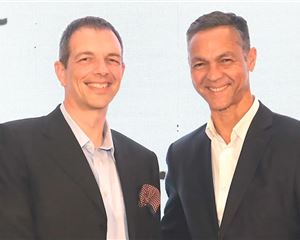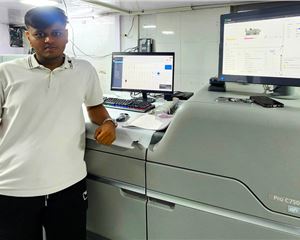Brands are now approaching their customers differently: Ranesh Bajaj of Vinsak - The Noel D'Cunha Sunday Column
In a conversation with Noel D’Cunha, Ranesh Bajaj of Vinsak explains how with print runs shrinking, connected packaging with QR codes, NFCs or RFIDs are all growing tremendously, and how personalisation is the key and not digital.
Read more in this Sunday Column
04 Dec 2022 | By Noel D'Cunha
Noel D’Cunha (ND): What’s the latest update from your factory?
Ranesh Bajaj (RB): Our manufacturing division is growing strong in this financial year. We have added a R&D department, and will increase our production capacity by 50% in the financial year 2022-2023. We will also increase our floor area by 50% by the end of the year. Among our products, the high build systems and digital foiling systems have found excellent responses in the trade shows around the world, and we now have multiple orders for the same.
ND: Which type of technologies are dominant in digital short-run label space today?
RB: In the digital printing business for labels, the wet toner from HP Indigo, the dry toner from Xeikon and Konica Minolta and a host of UV inkjet systems are getting popular in the market. Vinsak, however, focuses more on digital finishing solutions, which is our core. Our flagship product, the AB Graphics Digicon Series 3 Platform is still the market leader in terms of technology as well as longevity. We have multiple installations of the Digicon series 3 in India and this continues to grow. For entry level or low budget customers, we offer the Vinsak USAR platform which has a good price-performance ratio.
ND: What does your market survey or conversations with customers indicate about what is happening on the ground in the food and FMCG sectors?
RB: The Food and FMCG sectors are opting for sustainable and functional packaging. As this reset happens, it is a unique time in the packaging history when new players and technology can be disruptors. Established players need to retool their kits to meet the new demands and thus, fresh players will also have a level playing field.
Among other observations, labels and packaging grew during the pandemic and will continue to grow. Most converters are adding capacity and also venturing into newer territories of packaging. Plus, new players coming in from the sheetfed and corrugated businesses. Even gravure printers are opting for more narrow-web presses for short-runs.
ND: With home-grown brands exploding, there will be more and more demand for digital plus personalisation, are there solutions for this space? If yes, what...
RB: New and established brands are all now approaching their customers differently. While runs may have become shorter for all, connected packaging with QR codes, NFCs or RFIDs are all growing tremendously. Please appreciate the fact that personalisation is the key and not digital. A brand is agnostic to the printing process as long as the print quality and cost per print is met. There are a number of personalisation solutions available, either entirely digital, or hybrid with the static info being printed with traditional processes and personalisation being done digitally either online or offline.
ND: What is Vinsak doing in this space?
RB: We, at Vinsak, believe in offline personalisation, as this is the most economical process. Usually personalisation requires much shorter runs, has lower running speeds, and requires versioning. An offline system combined with a high speed flexo press gives the best combination for packaging as both processes can work at optimum efficiency.
ND: What are the various post-press embellishments in digital print today? If you can share applications and collateral?
RB: The embellishments possible are the same for digital print as well as conventional print. Typical solutions include hot and cold foiling, including digital foiling; embossing matt, tactile and high-build varnishes; QR codes in foil; cast and cure and similar special laminations; metallic doming; 3D effects using screen printing systems and multilayer label production using crossover units.
ND: What is your view about inline versus offline?
RB: Inline and offline finishing both have their share of pros and cons, depending on a team’s top priorities and goals. Typically, if you have long runs of the same product (for example, scratch cards or coupons) then it makes sense to do all finishing processes inline. In the case of shorter runs of different products, offline makes more sense, as you can balance out production speeds of different processes to keep the overall productivity high. Also, wastages and set up times are usually lower in offline machines for short runs. All in all, we do prefer the offline process of finishing for most digital operations.
ND: CIJ vs thermal for heads? When to deploy what?
There are three inkjet types – CIJ, DOD and thermal. I assume you are asking for coding and marking but Vinsak does not operate in that market and will not be able to advise much. For high volume QR code or personalisation, DOD is the market leader and continues to grow. Our VIS 1200 K range and the 720i range have more than 500 installations globally.
ND: What is the new frontier?
RB: The new frontier is UV inks which are food grade. Same for coatings which are plastic-free. The whole packaging industry is facing the challenge of finding new sustainable substrates, inks coatings, etc to make the world free of single-use plastic. Whatever R&D is happening for these new materials is going to be a game-changer.
ND: Rotary die-cutting or laser to maximise ops?
RB: Not rotary, but semi-rotary die-cutting for digitally printed labels is currently the new norm. While a number of companies are now offering such equipment and flexible dies now being locally produced in India, this is a mature way forward.
Laser cutting has been on the horizon for a few years now. It has several issues, including high capital cost, inability to cut some plastic substrates, burr on the edges of the cut or burn marks, and very slow production speed. We assume that this technology will take another five years to mature. Having said that, early adopters will be seen in India soon. We should be able to install a ABG DigiLase system very soon in India.
ND: Who are your technology partners today? What do they bring to the ops?
RB: For digital finishing, our premium partner is ABG international of the UK. It has been a global market leader in label finishing with developing solutions ahead of the market needs and offering them to converters in the region. With more than 150 kit installed in India alone, they are the market leader in terms of technology for sure.
For flexo printing, Lombardi from Italy has been our technology partner with more than 70 installations in India in the last six years. Needless to say, Lombardi offers the best price to performance ratio an European machine can offer in the market today.
For short run labels, Iwasaki from Japan has been offering excellent solutions. The new IF 330, which is a short-run flexo press with intermittent feeding, offers a unique short-run solution to existing narrow-web flexo printers to use their existing prepress and inks and still offer ultra short runs in a cost-effective manner.
Our new venture with Technocut offering on-press automation, including digital pressure control for die-cutting, a desma system for label shifting and digital pressure gauges, etc are all helping converters cut costs and improve quality and efficiency of production.
ND: Plans for next 12 months?
RB: Continue to support our existing customers with new technologies to help them grow the business. As raw material costs spiral, production efficiencies are becoming important, and we need to continue to innovate in that space.












 See All
See All